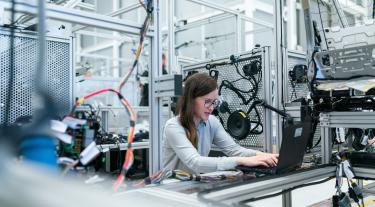In moving to a low carbon economy, companies have plenty of tools at their disposal, from new technologies to alternative sustainable business models. However, there is growing recognition of the importance of a critical element in the climate action journey – the human factor. Thinking about the way an enterprise is organised and how it rewards its workers and executives is an essential part of meeting carbon reduction goals.
Too often, a siloed mentality can be the biggest barrier to progress. A simple example is the fragmentation of accounting where cost structures are not aligned with revenue centres. If the business unit that is investing in energy efficiency or renewable energy does not reap the financial or environmental returns, it will be hard to align organisational goals and effectively manage carbon emissions across the enterprise.
This has been highlighted in the US by Climate Corps, a business student internship programme run by Environmental Defense Fund (EDF), an environmental group that places students in companies to identify energy efficiency opportunities. As part of the programme, students often get to move from department to department taking a holistic picture of an enterprise’s energy footprint. The results are striking. Since 2008, when the programme launched almost 1,000 graduate students in more than 450 organisations have identified more than US$1.5 billion in energy saving projects.
Incentivising change
Incentives are important, too. At Verizon, for example, a component of the annual bonus is based on reductions in carbon intensity. Within the sustainability function, performance is tied to specific goals, such as diverting waste or reducing water usage. “Now it’s in everyone’s performance agreement, and all of a sudden I have 140,000 people caring about sustainability,” says James Gowen, head of its global supply chain operations and chief sustainability officer.
Companies also need to build capacity internally through training programmes and the dissemination of information about climate action. “There’s a big element of creating awareness and equipping people with the right learning materials to be able have these conversations with clients,” says Daniel Klier, group head of strategy and global head of sustainable finance at HSBC.
The good news is that sustainability initiatives can be a way of engaging employees. “When we ask people about pride in BT, we get very positive feedback about sustainability,” says Gabrielle Ginér, BT’s head of environmental sustainability. “It comes down to people – and people that work on this tend to be personally very passionate about it.”
If employees represent a powerful cohort driving the sustainability agenda, so do investors. “In the past 12 months, the active participation and involvement of our investors is increasing,” says Thomas Fusshöller, head of sustainability, environment and energy management at thyssenkrupp. “And these investors are really well prepared. They already know what we are doing in energy efficiency, our total carbon footprint and the CDP data we disclose, and on that basis we have a relatively deep discussion with them.”
Looking at the progress made by leading corporations it is clear that bringing their empoloyees and wider stakeholders on the journey with them, has helped ensure that their action on climate change has had the greatest possible impact.
Read the full series
Part 1 - A time for corporate climate action
Part 2 - First steps in emissions reductions: energy efficiency in your own operations
Part 3 - Big benefits await those who tackle supply chain emissions
Part 4 - New climate opportunities are downstream
Part 5 - Power of the people: engaging your stakeholders on climate change



